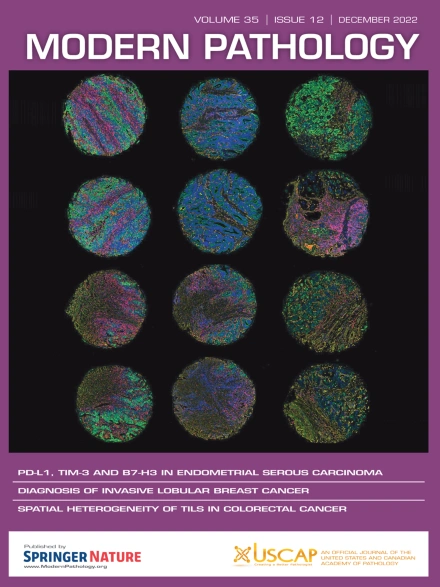伴有和不伴有食管移植物抗宿主病的干细胞移植患者食管活检的特征
IF 7.1
1区 医学
Q1 PATHOLOGY
引用次数: 0
摘要
移植物抗宿主病是造血干细胞移植(HSCT)的主要并发症。结肠GVHD的组织学诊断标准和几个分级系统已经被描述;然而,对于食管GVHD (eGVHD),迄今为止的报道有限。本研究共纳入130例食管活检HSCT患者,中位年龄44岁(2-77岁),男性居多(54.6%)。其中82例(63%)临床诊断为eGVHD。病例分为两组:无凋亡小体、角化异常细胞或溃疡(1组,无eGVHD的组织学证据)(42%)和至少具有上述特征之一(2组)(58%)。组2患者与外胃肠道GVHD相关(p=0.024),临床诊断为eGVHD (p=0.001),年龄较大(p=0.001)本文章由计算机程序翻译,如有差异,请以英文原文为准。
Characterization of Esophageal Biopsies from Stem Cell Transplant Patients With and Without Esophageal Graft-Versus-Host Disease
Graft-versus-host disease (GVHD) is a major complication of hematopoietic stem cell transplantation (HSCT). Histologic diagnostic criteria and several grading systems have been described for colonic GVHD; however, for esophageal GVHD (eGVHD) limited reports exist to date. In this study, a total of 130 patients with esophageal biopsies of HSCT were included, with a median age of 44 years (2-77 years) and a male predominance (54.6%). Of these, 82 (63%) had a clinical diagnosis of eGVHD. Cases were divided into 2 groups: those without apoptotic bodies, dyskeratotic cells, or ulceration (group 1, no histologic evidence of eGVHD) (42%) and those with at least one of those features (group 2) (58%). Group 2 cases were associated with extragastrointestinal tract GVHD (P = .024), a clinical diagnosis of eGVHD (P = .001), older age (P < .001), stem cells derived from peripheral blood (P < .001), higher number of intraepithelial lymphocytes (P = .002), presence of acute inflammation (P < .001), and basal cell hyperplasia (P = 0.016). Apoptotic bodies were seen in 65 (89%), dyskeratotic cells in 27 (37%) and an ulcer in 28 (37%) of the group 2 cases. The sensitivity (Sn), specificity (Sp), and accuracy (acc) of the group 2 cases for a clinical diagnosis of eGVHD was 68.3%, 60.4%, and 65.4%, respectively. Apoptotic bodies (P = .012) and dyskeratotic cells (P < .001) but not ulceration (P = .881), were associated with a clinical diagnosis of eGVHD. The Sn, Sp, and acc for apoptotic bodies, dyskeratotic cells, and ulcer were 59.3%, 63.8% and 60.9%; 30.9%, 95.7%, and 54.7%; and 21.9%, 79.2%, and 43.1%, respectively. Cases with only apoptotic bodies or ulceration were considered as possible GVHD, and those with dyskeratotic cells as likely GVHD, which were associated with GVHD-specific survival (P = .030). This study provides a comprehensive characterization of the esophageal histologic findings in patients with HSCT. Further studies are needed to corroborate these findings in other patient populations.
求助全文
通过发布文献求助,成功后即可免费获取论文全文。
去求助
来源期刊

Modern Pathology
医学-病理学
CiteScore
14.30
自引率
2.70%
发文量
174
审稿时长
18 days
期刊介绍:
Modern Pathology, an international journal under the ownership of The United States & Canadian Academy of Pathology (USCAP), serves as an authoritative platform for publishing top-tier clinical and translational research studies in pathology.
Original manuscripts are the primary focus of Modern Pathology, complemented by impactful editorials, reviews, and practice guidelines covering all facets of precision diagnostics in human pathology. The journal's scope includes advancements in molecular diagnostics and genomic classifications of diseases, breakthroughs in immune-oncology, computational science, applied bioinformatics, and digital pathology.
 求助内容:
求助内容: 应助结果提醒方式:
应助结果提醒方式:


